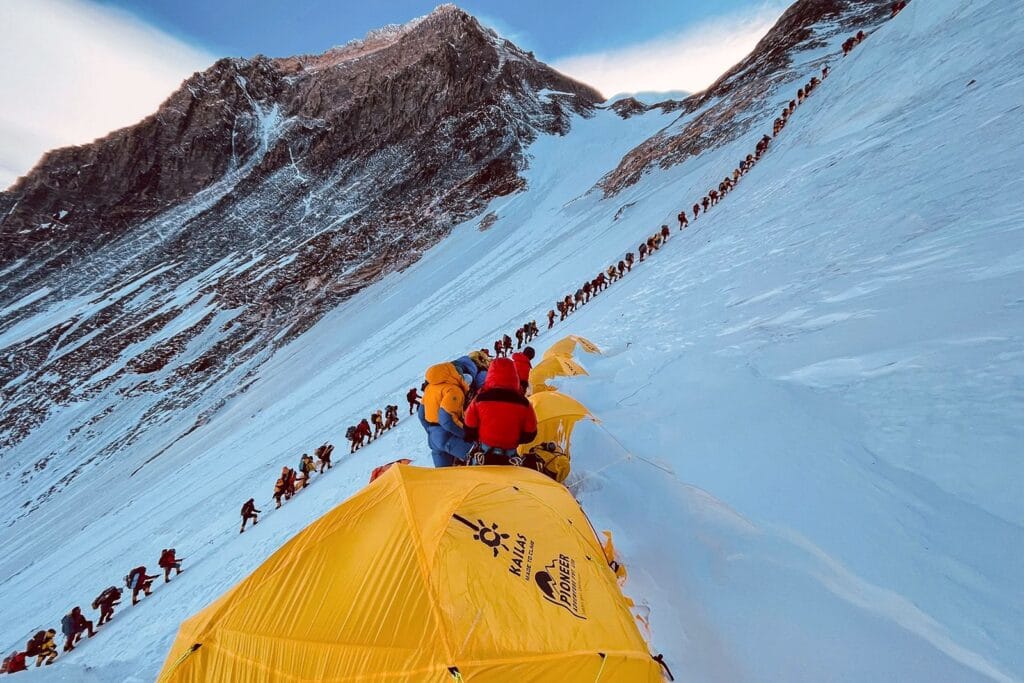Mount Everest, or Qomolangma as it is known in Tibetan, is not just the tallest mountain in the world. It is a symbol of human ambition, an ultimate challenge that has drawn climbers from across the globe for decades. Standing at 8,848 meters, it is a place where dreams are tested against the limits of physical endurance and mental fortitude. Yet, it is not just the mountain’s height that poses a challenge; it is the environment, the weather, the thin air, and the very nature of the climb that make Everest an iconic and formidable opponent.
In her novel 8848 Metres, Silène Edgar takes readers on an unforgettable journey to the summit of this legendary peak, through the eyes of 15-year-old Mallory. What sets this novel apart is its multi-layered narrative, which goes beyond the physical challenges of the climb to explore deeper themes of self-discovery, family bonds, environmental awareness, and cultural encounters. The story is a coming-of-age tale that resonates with readers of all ages, offering a rich, immersive experience that is as enlightening as it is inspiring.

The Heroine’s Journey: Mallory’s Path to Self-Discovery
At the heart of 8848 Metres is Mallory, a teenager who is both passionate and determined. Named after the famous British mountaineer George Mallory, who disappeared on Everest in 1924, she carries with her the legacy of a name synonymous with adventure and perseverance. Mallory’s journey to Everest is not just a physical expedition; it is a quest for identity, a search for meaning, and a test of her inner strength.
Mallory’s relationship with her father, who introduced her to mountaineering at a young age, is central to her character development. Their bond is strong, rooted in shared experiences on various mountains around the world. However, Everest is a different beast altogether. As they prepare for the climb, Mallory begins to question her motivations. Is she climbing for herself, or is she driven by her desire to make her father proud? This internal conflict is a key theme in the novel, as Mallory grapples with the pressure of living up to expectations, both her own and those imposed by others.
Edgar skillfully portrays the complexities of the father-daughter relationship, highlighting how the dynamics shift as Mallory matures. The mountain becomes a metaphor for the challenges of growing up, of navigating the often-treacherous terrain of adolescence, and of finding one’s own path in life. As Mallory ascends the mountain, she is also ascending to a new level of self-awareness, learning to trust in her own abilities and to define success on her own terms.

The Physical and Mental Demands of the Climb
One of the most striking aspects of 8848 Metres is Edgar’s vivid and realistic depiction of the physical and mental challenges involved in climbing Everest. Through Mallory’s experiences, readers are given an intimate glimpse into the harsh realities of high-altitude mountaineering. The thin air, freezing temperatures, and treacherous terrain are described in such detail that one can almost feel the biting cold and the strain of each breath.
Edgar does not romanticize the climb; instead, she presents it in all its brutal reality. Mallory and her father, along with their fellow climbers, must contend with altitude sickness, exhaustion, and the constant threat of avalanches and storms. The psychological toll is just as intense, as the isolation, fear, and pressure to succeed weigh heavily on each climber. Edgar captures the delicate balance between pushing one’s limits and recognizing when to turn back, a decision that can mean the difference between life and death on Everest.
The novel also explores the camaraderie and conflicts that arise within the group. Living in close quarters for an extended period, the climbers must navigate the tensions that inevitably surface in such extreme conditions. Edgar’s portrayal of group dynamics adds another layer of depth to the story, showing how personalities clash, bonds are formed, and sacrifices are made in the pursuit of a common goal. The mountain becomes a crucible in which the true character of each climber is revealed.

The Broader Context: Tourism, Environment, and Culture
While 8848 Metres is first and foremost a personal journey, Edgar also situates the story within a broader context, addressing important issues such as the impact of tourism on Everest, environmental degradation, and cultural encounters. Through the character of Aurélie, a French woman who has lived in Lhasa for 20 years and works with the Clean Everest organization, Edgar highlights the environmental challenges posed by the increasing number of climbers on the mountain.
Aurélie’s work involves cleaning up the tons of waste left behind by climbers—everything from discarded oxygen tanks to plastic waste. Her character is inspired by Edgar’s own cousin, who is involved in similar environmental work in the region. This connection adds an authentic and personal touch to the novel, underscoring the real-world consequences of the growing commercialization of Everest.
Edgar’s portrayal of the local Sherpa community is also noteworthy. The Sherpas, who are integral to any Everest expedition, are often the unsung heroes of the climbs. They are the ones who carry the heavy loads, set up the camps, and guide the climbers through the most dangerous sections of the mountain. Yet, their contributions are often overlooked or undervalued. In 8848 Metres, Edgar gives voice to these indispensable members of the climbing community, shedding light on their skills, their culture, and the risks they take to support the ambitions of others.
The novel also touches on the spiritual aspects of the climb. As Mallory and her father journey through the Himalayas, they encounter various Buddhist practices and beliefs. These encounters prompt Mallory to reflect on the nature of her quest and the values she holds. Edgar uses these moments to introduce readers to Buddhist concepts, offering a gentle, educational exploration of spirituality that enhances the novel’s thematic richness.

A Coming-of-Age Story for All Ages
Although 8848 Metres is marketed as a young adult novel, its appeal extends far beyond this demographic. The themes of self-discovery, resilience, and the pursuit of dreams are universal, making the novel accessible to readers of all ages. Edgar’s writing is both accessible and profound, balancing the intensity of the climb with moments of introspection and growth.
Mallory’s journey is one that resonates with anyone who has ever faced a significant challenge, whether it be climbing a mountain or navigating the complexities of life. Her determination, her struggles, and her ultimate triumph are inspiring, reminding readers that the greatest achievements are often those that push us to our limits, both physically and mentally.
Edgar’s decision to tell the story through a mix of traditional narration, telephone conversations, and newspaper articles adds a dynamic and engaging structure to the novel. This narrative technique allows readers to experience the climb from multiple perspectives, deepening their understanding of the challenges and stakes involved. The interweaving of different voices and formats also mirrors the complexity of the climb itself, where multiple factors—physical, mental, emotional, and environmental—interact and influence the outcome.

Conclusion: The Summit and Beyond
In 8848 Metres, Silène Edgar has crafted a novel that is as multifaceted as the mountain it depicts. Through Mallory’s journey, readers are invited to explore not only the physical demands of climbing Everest but also the deeper, more personal challenges that such an endeavor entails. The novel is a celebration of human resilience, a meditation on the importance of environmental stewardship, and a tribute to the rich cultural heritage of the Himalayas.
Edgar’s ability to blend these elements into a cohesive and compelling narrative is a testament to her skill as a writer. 8848 Metres is not just a story about reaching the highest point on Earth; it is a story about reaching the highest points within ourselves, about pushing beyond what we thought possible, and about discovering who we truly are when faced with the most daunting challenges.
For anyone who has ever dreamed of climbing Everest, or for those who simply seek a powerful and moving story of determination and self-discovery, 8848 Metres offers an unforgettable journey. It is a novel that stays with you long after the final page is turned, much like the echoes of a climber’s footsteps in the snow at the top of the world.









